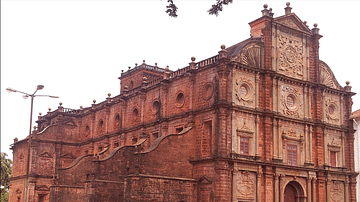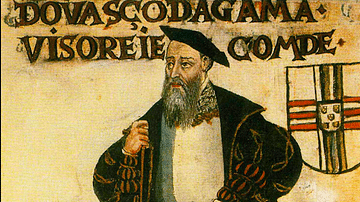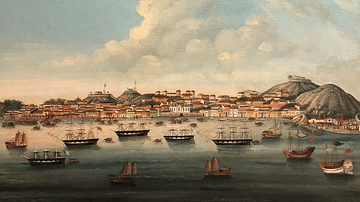Throughout the 15th century, the Portuguese Crown yearned for a piece of the Far Eastern spice trade. For centuries this trade had been dominated by the Venetians who obtained pepper, cloves, nutmeg, ginger and cinnamon from their Middle Eastern trading partners, the Mamluks and Ottomans.

In 1497, King Manuel I of Portugal (r. 1495-1521) selected the nobleman Vasco da Gama (c. 1469-1524) to find the way to the spices. Da Gama was to follow the route to the Indian Ocean pioneered by Bartolomeu Dias (c. 1450-1500), who had learned to use the strong east winds of the mid-Atlantic to hurl him and his crew around the Cape of Good Hope.
Da Gama's Voyage
Da Gama set off on 8 July 1497 with a squadron of four well-armed ships, three years of supplies and a store of cheap goods to trade with what was assumed would be unsophisticated natives. Unfortunately, instead of boomeranging directly around the Cape, da Gama got caught in the doldrums of the central Atlantic and did not make it around the Cape. After sailing for 95 days, he landed 125 miles north of it at St Helena Bay.
By the time they reached land, most of da Gama's crew were in desperate shape with scurvy – their hands and feet grotesquely swollen, and their bloody gums distended over their teeth. Scurvy was to become the scourge of all the future European voyages to India and led to countless deaths. No one escaped the symptoms after a couple of months at sea without fresh fruit and vitamin C. Fortunately, the healthiest of da Gama's crew were still able to mend sails, collect water, and hunt for fresh meat allowing them to continue their journey. During one of the missions to collect water, the crew had a nasty encounter with the local Khoikhoi, and da Gama received a minor spear wound. The Portuguese resolved to never again approach land without being heavily armed and ready to "fight at the slightest provocation" (Crowley, 2015).
Da Gama then headed down the rest of the west coast, travelled through the stormy seas around the Cape and passed the Great Fish River (Eastern Cape, South Africa) where Dias had previously anchored, before sailing into waters previously unknown to Europeans. With Christmas on the way, da Gama gave the coast they were passing the name Natal.
Vasco da Gama's first landing on the eastern coast of Africa was on Mozambique, in early March of 1498. At first, he had pleasant interactions with the local natives who were interested in trading for his cheap trinkets, but this atmosphere changed dramatically when he arrived at his first settlement of Muslim traders in Mozambique City. The local sultan was insulted by the poor quality of the brass pots, trinkets, and clothing that he was offered, and after a series of altercations, da Gama fled the city and continued north.
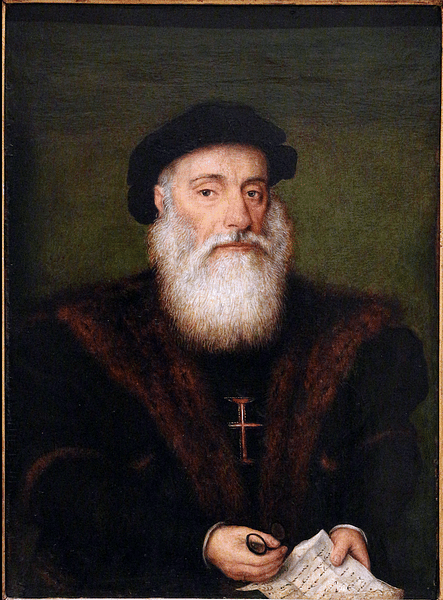
As da Gama moved up the coast, he was astonished to find a series of rich, sophisticated city-states. What he had stumbled upon was the south-western periphery of the prosperous trade network that stretched all the way from Africa to India, down to Malaysia, and through the islands of Indonesia to China. He was moving into a largely Muslim world that was much more deeply layered and complex than the Portuguese had anticipated in their wildest dreams.
Da Gama also made the startling discovery that Muslim trading vessels were unarmed, a situation totally alien to Mediterranean traders. Genoa and Venice had long been waging commercial wars at sea along with the Catalans, Spaniards, and Franks. Da Gama realized it would be easy to prey on any Muslim trading vessels he came upon, taking gold, silver, foodstuffs, and hostages from the unarmed ships.
Da Gama in India
Da Gama made a brief stop at Mombasa where the locals proved hostile and then on 14 April he arrived at the friendlier port of Malindi, whose sultan was at war with Mombasa. Da Gama was able to acquire some trade goods there and, most importantly, was provided with a Gujarati pilot, who showed the Portuguese the way to India on the monsoon winds.
While in Malindi, da Gama grew quite excited when four Hindu trading vessels arrived from Calicut, India. He could not fully understand what these sailors were trying to tell him, but they were clearly not Muslims, and he became convinced that they practised a version of Christianity. The Portuguese would later learn that they were Hindu, but at the time da Gama was convinced that a pocket of Christianity must exist in this sea of Muslims.

Vasco da Gama left Malindi for India on 24 April 1498 and arrived at Calicut less than a month later. Here he found a Hindu kingdom, ruled by the king of Calicut, the zamorin or samoothiri. When da Gama showed the zamorin the gifts that he had brought, they were immediately rejected, but after a tense, confusing audience and shows of force on both sides, da Gama was allowed to do some trading. However, the zamorin made it clear that da Gama would pay customs duty, just like any other merchant.
A frustrated da Gama left Calicut on 20 September 1498, ignoring local warnings that the monsoons had not yet turned. His ships subsequently became trapped at sea by still winds and when they did finally reach Malindi 132 days later, his sailors were again in terrible shape with scurvy. So many had died that da Gama could no longer man all of his remaining ships, and the leakiest was scuttled. His two remaining ships rounded the Cape of Good Hope with little incident and reached the western coast of Africa on 25 April 1499. Here the ships got separated and headed to Portugal by different routes. Vasco da Gama stayed behind with his dying brother on Cape Verde for about a month and was the last to arrive in Lisbon in early September.
Vasco da Gama was given a hero's welcome by the king for opening the sea route to India. His success had come at a great cost in human lives, but the small quantities of spices he had brought back signaled great future profits for the Crown.
Portuguese Conquest of India
Upon da Gama's return, the Portuguese Crown began a concerted naval strategy aimed at capturing – by force or by treaty – all the major Indian Ocean ports. Pedro Álvares Cabral (1467/1468 to c. 1520) was chosen to lead the next Indies expedition and he was ordered to persuade the zamorin of Calicut to fall in line, take possession of any 'Moor' merchant ships he encountered and bring back as much spice as he could. He was also tasked with delivering a group of Franciscan missionaries to Calicut to help the Hindus get their religion in line with Catholic orthodoxy.
Cabral was given a fleet of 13 vessels, and he sailed out on 9 March 1500. Following the now-standard western swing into the Atlantic Ocean, Cabral added discovery to his mission when he swung out too far and stumbled upon Brazil. After lingering for a while to take on provisions, he resumed his journey and headed east, where his fleet was hit by a nasty storm and five ships were lost.
The remaining seven did manage to swing around the tip of Africa. and rendezvous in the Mozambique Channel. From there they headed north along the coast of Africa to Sofala, Kilwa, and Malindi, where they procured fresh produce and water, and then continued across the Ocean to India, reaching Calicut on 13 September. He arrived carrying much more luxurious gifts for the zamorin and proper letters of introduction from King Manuel. This time a commercial treaty was successfully negotiated, and he was allowed to set up a factory to process spices.
All was going well until Cabral decided to seize his first Arab merchant ship loaded with spices. In response, the Arabs rioted and killed over 50 Portuguese soldiers and most of the Franciscan friars. Cabral reacted by seizing another ten Muslim ships, pirating their cargoes, killing their crews and setting the ships ablaze. He topped this all off with a full day of shore bombardment of Calicut and another nearby port. On 24 December, Cabral left a smoldering Calicut and sailed south along the coast towards Cochin. Here, Cabral found a receptive environment and was able to trade for enough pepper and other goods to fill the holds of his ships. He was also allowed to establish a small trading post.
Cabral was forced to leave Cochin hurriedly on 16 January 1501, when he learned that the zamorin had sent a flotilla of some 80 warships to engage him. These he managed to elude, and after a final friendly stop in Cannanore arrived back in Lisbon five months later on 23 June 1501, as another hero. He brought back profitable quantities of spices and began to shake up the long-established patterns of trade by the Indians and Arabs.
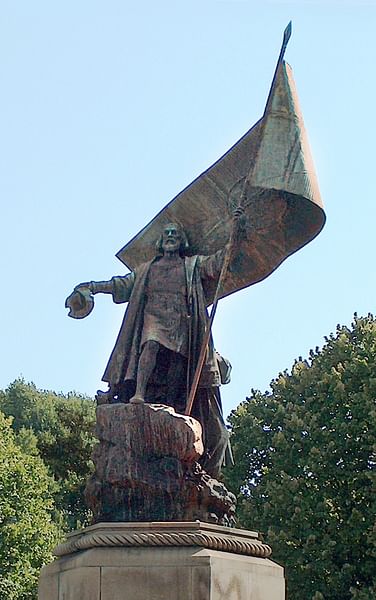
Over the next five years, Manuel would dispatch a volley of fleets of increasing size, 81 ships in all, to ensure success in a life-and-death struggle for a permanent position in the Indian Ocean. It was a supreme national effort that called on all the available resources of manpower, shipbuilding, material provision and strategic vision to exploit a window of opportunity before Spain could react. "In the process the Portuguese took both Europe and the peoples of the Indies by complete surprise." (Crowley, 101)
Da Gama was chosen in 1502 to lead the next India armada. He was given command of ten ships, supported by two flotillas of five ships each commanded by his uncle and nephew. His explicit orders were to take control of Indian trade by forcing the East African sultans and the zamorin of Calicut to bow down to Portuguese might. This he set out to accomplish in what became a gruesome rampage of piracy and massacre. After a successful push around the Cape of Good Hope, da Gama began his onslaught by terrorizing the Muslim ports up and down the African east coast. Next, he ambushed an Arab ship filled with pilgrims, seized its cargo and then set it afire, burning to death hundreds of passengers including women and children. He then headed to Calicut to force a trade agreement with the zamorin, who was initially receptive until da Gama demanded the expulsion of all Muslims in the city.
To intimidate the zamorin, da Gama took one of his high priests hostage and had him tortured by cutting off his lips and ears and sewing a pair of dog's ears to his head. He then bombarded unfortified Calicut for two days, grabbed more captives from ships in the harbor, cut off their noses and ears and sent these to the zamorin. The enraged zamorin responded by sending a huge fleet to ambush da Gama, who was forewarned and fled. He loaded up his ships with spices at the friendly ports of Cochin and Cannanore and left India in a fury, attacking and looting several Muslim ships along the Malabar Coast on the way home. Da Gama arrived in Lisbon in September 1503 to a mostly cool reception from Manuel I. He had brought back much spice and had temporarily disrupted Indian shipping but had once again failed to bring the zamorin into submission, even with extreme barbarity.
The First Viceroy of Portuguese India
In 1505, King Manuel I decided that it was time to establish a permanent presence in the Indian Ocean, and Francisco de Almeida was appointed the first viceroy of Portuguese India. Almeida was charged with building forts and trading posts all along the East African and Indian coasts and bottling up Muslim trade with Calicut. He was given a force of 22 vessels, 1000 sailors, and 1500 soldiers to do the job.
After rounding the Cape of Good Hope, Almeida began his mission by ravaging East Africa, storming and sacking Kilwa, torching Mombasa and Mozambique, and in essence taking full control of a 1000-mile stretch of the African east coast. He then set off for India, leaving a garrison of 550 men behind in Kilwa. On 13 September, Almeida stopped at nearby Anjadip (Anjediva) Island, where he built his first fort, and then travelled to Cannanore, where he built another fort and left a force of 150 men and two ships.
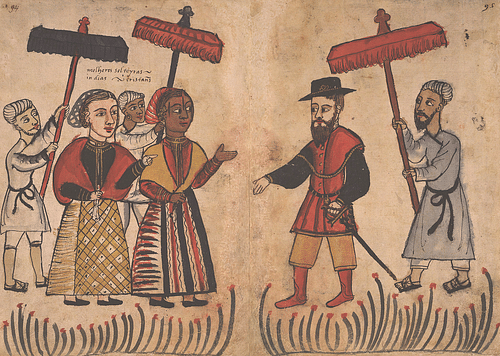
Almeida next sailed to Cochin, and to his horror, he found out that the traders left behind by Cabral had all been killed. He retaliated by sending his son Lourenço with six ships to Quilon harbour where he destroyed 27 ships. Upon leaving, Lourenço encountered a huge flotilla sent by the zamorin to engage him and roundly defeated them, killing between 3,000 and 4,000 and sinking 200-300 vessels.
The Portuguese-Mamluk Naval War
As more and more Arab ships were destroyed by the Portuguese in Indian harbors, desperation grew among the Mamluks and Venetians on how to save their lucrative trade network. Finally in 1505, Sultan Qansuh al-Ghuri ordered the building of a fleet to fight the Portuguese. The fleet was completed in November and under the leadership of Amir Husain Al-Kurdi, left Suez and arrived at Diu in 1507, where it joined up with local Indian forces and surprised a much smaller fleet of Lourenço in the Battle of Chaul, sinking six of eight ships and killing the viceroy's son.
The governor of the city Meliqueaz wrote to the viceroy trying to appease him by saying his son had fought bravely, but a furious Almeida wrote back that "… in Chaul you fought my people, and killed a man who was called my son, and I come with hope in God of Heaven to take revenge on them and on those who assist them" (Crowley, 227).
The viceroy rallied his forces, and on 2 February 1509 crushed the Egyptian–Indian coalition and had most of the Egyptian captives hanged, burned alive, or dismembered. Meliqueaz was forced to surrender, pay a hefty tribute and return his hostages in good health. The remnants of the Egyptian fleet returned to Egypt, and the Mamluks never seriously challenged the Portuguese again.
Albuquerque Takes Over
Almeida had successfully established Portuguese sea power in the Indian Ocean, but a secure naval base had not been established. A central naval base was needed where the Portuguese could maintain a permanent fleet to control all the Indian Ocean Sea lanes. This job fell to Alfonso de Albuquerque (1453-1515), who replaced Almeida as viceroy in 1509 after a brief power struggle. He established Portuguese Goa on the Malabar Coast – it had a good harbor, an active shipbuilding industry, and was a major trade center.
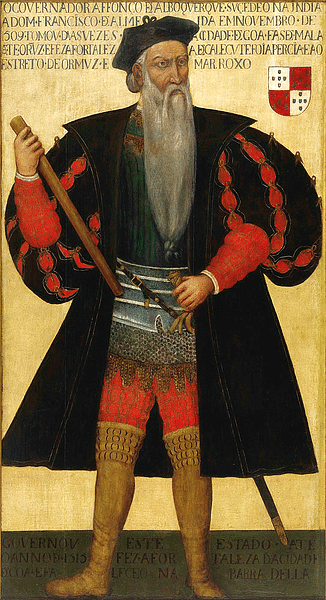
Just before Albuquerque could get started on this grand plan, another fleet arrived in the Indian Ocean under Marshal Fernão Coutinho, with specific instructions to overthrow the zamorin of Calicut. Albuquerque reluctantly joined in this endeavor with disastrous consequences. In a direct assault on the city, the combined forces of Coutinho and Albuquerque took over and looted the zamorin's palace, but the locals rallied in bloody street fighting, killing Coutinho and seriously wounding Albuquerque. Only a small group of surviving Portuguese were able to flee the city, and once again the Portuguese had failed to subdue the zamorin. The Portuguese would continue to struggle with the forces of the zamorin of Calicut for the next century.
Miraculously recovering from his wounds, Albuquerque returned to his original plan a few months later and joined forces with the local Hindus in 1510 to take Goa from the Sultanate of Bijapur. He was supported by Timoji, a Hindu pirate who commanded a force of 2000 men. Goa would remain the capital of the Portuguese Empire's colonies east of the Cape of Good Hope, the Estado da India, until 1961.
The Portuguese Legacy
In addition to their successful conquests of India and eastern Africa, the Portuguese under Albuquerque tried to take over all the main trade routes of the East, by conquering the key Muslim-controled ports of Ormuz, Malacca, and Aden. Ormuz stood at the entrance to the Persian Gulf through which merchants transported spices to the Middle East, Aden was at the base of the Red Sea and served as the spice portal to Egypt, and Malacca at the tip of the Malay Peninsula served as the gateway to the Bay of Bengal, the Spice Islands, and China.
Albuquerque led missions that were successful in bottling up Ormuz and Malacca, but he was unable to secure Aden. Muslim merchants would exploit this hole in the Portuguese Indian Ocean empire to continue to move spices through the Red Sea to Muslim Egypt, where they continued to be traded to the Venetians. The Portuguese would come to dominate the spice trade in Northern Europe, but the Venetians would hold onto most of their eastern European trade.



